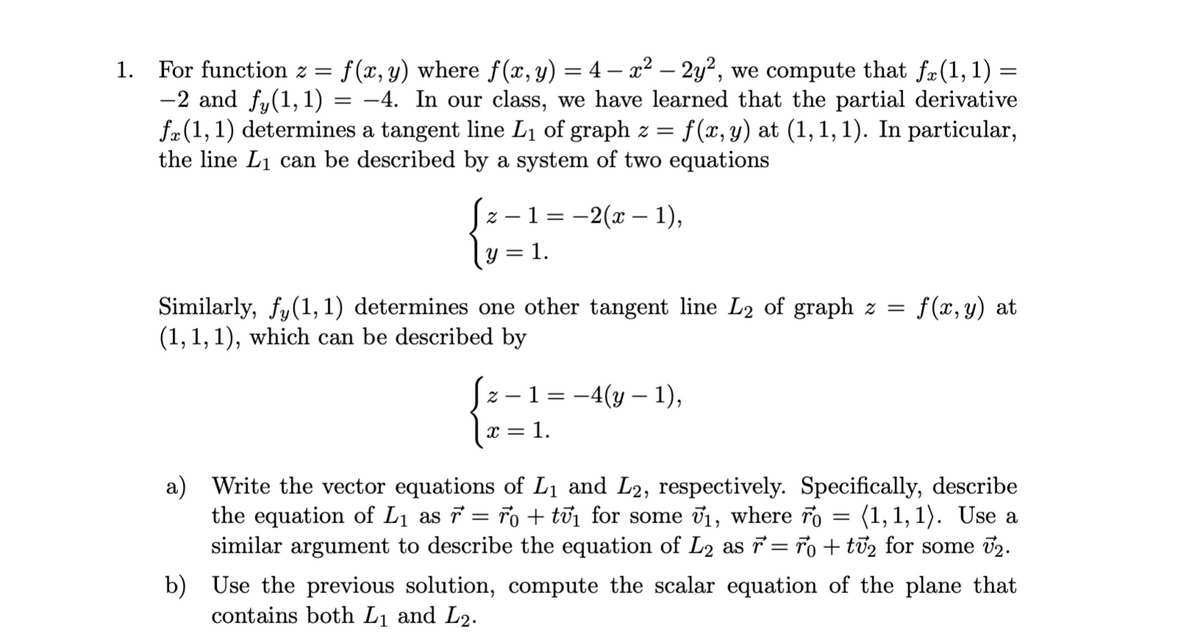1. For function z = f(x, y) where f(x, y) = 4 – x² – 2y², we compute that fa(1,1) = -2 and fy(1,1) = -4. In our class, we have learned that the partial derivative fæ (1, 1) determines a tangent line L1 of graph z = the line L1 can be described by a system of two equations f(x, y) at (1, 1,1). In particular, z – 1= -2(x – 1), = 1. Similarly, fy(1, 1) determines one other tangent line L2 of graph z = f(x, y) at (1, 1, 1), which can be described by [2 -1= -4(y – 1), x = 1. a) Write the vector equations of L1 and L2, respectively. Specifically, describe the equation of L1 as 7 = ĩo + tủi for some v1, where ro = similar argument to describe the equation of L2 as = ro+ td2 for some v2. (1, 1, 1). Use a b) Use the previous solution, compute the scalar equation of the plane that contains both Lị and L2.
1. For function z = f(x, y) where f(x, y) = 4 – x² – 2y², we compute that fa(1,1) = -2 and fy(1,1) = -4. In our class, we have learned that the partial derivative fæ (1, 1) determines a tangent line L1 of graph z = the line L1 can be described by a system of two equations f(x, y) at (1, 1,1). In particular, z – 1= -2(x – 1), = 1. Similarly, fy(1, 1) determines one other tangent line L2 of graph z = f(x, y) at (1, 1, 1), which can be described by [2 -1= -4(y – 1), x = 1. a) Write the vector equations of L1 and L2, respectively. Specifically, describe the equation of L1 as 7 = ĩo + tủi for some v1, where ro = similar argument to describe the equation of L2 as = ro+ td2 for some v2. (1, 1, 1). Use a b) Use the previous solution, compute the scalar equation of the plane that contains both Lị and L2.
Calculus: Early Transcendentals
8th Edition
ISBN:9781285741550
Author:James Stewart
Publisher:James Stewart
Chapter1: Functions And Models
Section: Chapter Questions
Problem 1RCC: (a) What is a function? What are its domain and range? (b) What is the graph of a function? (c) How...
Related questions
Question
Could you solve a&b thank you!

Transcribed Image Text:f (x, y) where f(x, y) = 4 – x² – 2y², we compute that fæ(1, 1) =
1. For function z =
-2 and fy(1,1) = -4. In our class, we have learned that the partial derivative
fa(1, 1) determines a tangent line L1 of graph z = f (x, y) at (1, 1, 1). In particular,
the line L1 can be described by a system of two equations
1 = -2(x – 1),
- Z
y = 1.
Similarly, fy(1, 1) determines one other tangent line L2 of graph z =
(1,1, 1), which can be described by
f(x, y) at
z – 1 = -4(y – 1),
x =
=1.
a) Write the vector equations of L1 and L2, respectively. Specifically, describe
the equation of L1 as 7 = ro + tủi for some v1, where ro = (1, 1, 1). Use a
similar argument to describe the equation of L2 as = ro+ tū2 for some 02.
b) Use the previous solution, compute the scalar equation of the plane that
contains both Lị and L2.
Expert Solution
This question has been solved!
Explore an expertly crafted, step-by-step solution for a thorough understanding of key concepts.
This is a popular solution!
Trending now
This is a popular solution!
Step by step
Solved in 2 steps

Recommended textbooks for you

Calculus: Early Transcendentals
Calculus
ISBN:
9781285741550
Author:
James Stewart
Publisher:
Cengage Learning

Thomas' Calculus (14th Edition)
Calculus
ISBN:
9780134438986
Author:
Joel R. Hass, Christopher E. Heil, Maurice D. Weir
Publisher:
PEARSON

Calculus: Early Transcendentals (3rd Edition)
Calculus
ISBN:
9780134763644
Author:
William L. Briggs, Lyle Cochran, Bernard Gillett, Eric Schulz
Publisher:
PEARSON

Calculus: Early Transcendentals
Calculus
ISBN:
9781285741550
Author:
James Stewart
Publisher:
Cengage Learning

Thomas' Calculus (14th Edition)
Calculus
ISBN:
9780134438986
Author:
Joel R. Hass, Christopher E. Heil, Maurice D. Weir
Publisher:
PEARSON

Calculus: Early Transcendentals (3rd Edition)
Calculus
ISBN:
9780134763644
Author:
William L. Briggs, Lyle Cochran, Bernard Gillett, Eric Schulz
Publisher:
PEARSON

Calculus: Early Transcendentals
Calculus
ISBN:
9781319050740
Author:
Jon Rogawski, Colin Adams, Robert Franzosa
Publisher:
W. H. Freeman


Calculus: Early Transcendental Functions
Calculus
ISBN:
9781337552516
Author:
Ron Larson, Bruce H. Edwards
Publisher:
Cengage Learning